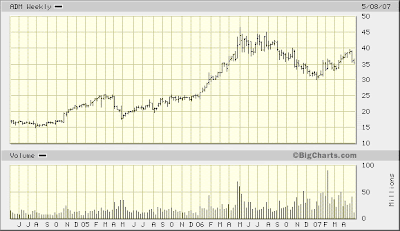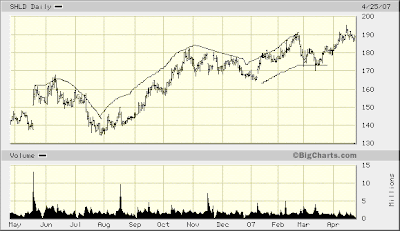The following are remarks from Eddie Lampert, Chairman of Sears Holdings (SHLD) to a conference held at the Third Avenue Mangement Investors Conference in 2003. It should be noted that this is prior to the Sears aquisition that created the Sears Holdings we today know. It should also be noted that Third Avenue was also a large investor in Sears along with Lampert. His insights into the Kmart deal almost creates the bluprint for the reasoning of the Sears one. These items are so informative when delivered by people the likes of Lampert of Buffett. The educational value of them alone is invaluable.
Overview and Summary of
Remarks by Edward S. Lampert
Founder and Manager of ESL Investments
Delivered at
The Third Avenue Management Investor Conference and Luncheon
November 18, 2003
Summarized/Edited
by
Kaushal B. Majmudar
Managing Partner
The Ridgewood Group
(www.ridgewoodgrp.com)
[Ed. Note: Edward S. Lampert of ESL Investments is an intelligent investor that we admire. As he has traditionally maintained a low profile, we were pleased to have the opportunity to hear from him at a recent event. We hope that others seeking to learn about intelligent investing can benefit from his thoughts as much as we did. This is a selective and personal record of what he said and so should not be taken literally.] Edward Lampert: [Comes to the podium after being introduced by Marty Whitman]. I will make some brief comments and then take questions.
About ESL
I started my firm in 1988 and began investing. I was inspired by Warren Buffett’s letters while still working on the Arbitrage desk at Goldman Sachs. We consider ourselves “Aggressive Conservative” investors [Note: A lot like Marty Whitman’s “Safe and Cheap” motto]. In investing, we seek to do a few things well, namely
1.) Understand the Business
2.) Understand the People Running the Business and
3.) Get safety from the price that we pay
Generally speaking, we focus on absolute returns in making investments. By the way, past performance as a measure of quality is wildly overrated. It would make a lot more sense to place more emphasis on and think about the people that put the track record together and the quality and value of the portfolio that they are managing.
About KMART
We invested in Kmart. Kmart was one of the worst managed companies in its industry. It was clearly distressed. Marty is one of the more sophisticated distressed securities investors and he was buying.
The standard Retail Bankruptcy process model is well established. People wait until Christmas and see what happens and then close the worst performing stores. Then the company hobbles along until the following Christmas and does the same thing again closing even more stores. It can be a slow process. Surprisingly, most of the Boards of Directors that put the company into bankruptcy stay in place until the company finally emerges under new ownership [pursuant to a plan of reorganization].
In the Kmart deal, neither I nor Marty were on the board or the creditors committee initially. Meanwhile, the professionals were making $10 to $20 million PER MONTH while the company was in bankruptcy. With that kind of money coming in, there would be low incentive to push to come our immediately. ESL and 3rd Ave. spent a lot of time trying to understand the existing process. They wanted to know the Company’s plan to emerge and the goals of the creditors committees.
Finally, Brandon (??) who works with Marty at 3rd Ave got onto the creditors committee. Their agenda (ESL and 3rd Avenue’s) was to have KMART emerge out of bankruptcy as soon as possible but with little debt.
The “Experts” said that KMART would never emerge from bankruptcy. The press was also extremely critical. As much as possible, everyone let Marty deal with the press because he is so frank and his comments on the matter were dead on. Most of the players involved in the process lacked urgency. This included many banks
and landlords (except those who actually wanted their space back). Lots of the players involved also probably had conflicts to deal with.
I have learned that it often comes down to who makes the decisions and also where the benefits and consequences fall – who benefits if the decisions work and who pays the price if it does not work. The large annuity aspect for advisors making $10 to $20 million per month made it less urgent for them to make it come out of bankruptcy. It was a difficult situation and a difficult process. However, ESL and 3rd Ave were able to influence the situation. Their power and leverage came from their willingness to put more money into the reorganized company as part of the plan (this was their source of power). In the process, they were able to force the shutdown of about 300 stores.
The plan they worked out was to take out the banks with cash (using money they invested). Trade creditors actually wanted the new equity. The Company ended up coming out of bankruptcy with $1 billion in cash and no debt. Because of Kmart’s consumer nature, perception was important. Now when it emerged from bankruptcy, the experts who said that it would never happen were wrong. However, they changed their tune and now started talking about how the Company would go right back into bankruptcy, a so called “Chapter 22” filling [i.e. Chapter 11 times 2]
More recently, they have been focused on trying to improve the operations and execution by KMART. There were already policies and procedures in place that people had not been following. People made a lot of improper decisions, but actually a big part of the problem was that they had been operating with the wrong “frame” for decision making. For any company, you need to have an overarching PHILOSOPHY to guide operations for profitability.
At KMART, they are trying to instill a teaching and learning culture by going back to first principles. This is challenging because in their case, they need to communicate to 170,000 people. They are simultaneously trying to improve the look of the stores and change the employee mix. They are thinking like owners in their approach to KMART. A lot of the successful companies in retail actually had owners (i.e. owner operators).
However, it is definitely an uphill battle. The Press does not understand what is going on at KMART. However, the Customers do and they have started getting compliments (from customers) again. Still they do have a lot of challenges.
ESL was established to invest like owners. The last 20 years has been about CEO as politician (e.g. Rumsfeld/Cheney) versus CEOs as owners. There is a whole system today that supports the rights of agents instead of the rights of shareholders. The Shareholder representation system is broken. Many of the recent SEC proposals are trying to introduce reforms to better align company, management and
shareholder interests. Good managements should be paid lots and lots of money because it is a hard job, but
only if they perform. You cannot pay people irrespective of performance. KMART was helped by the owner mentality that was possible because of presence and involvement of the large interested shareholders. Activist owners like ESL and 3rd Avenue help foster the proper balance between management and shareholders. This balance benefits all shareholders and not just the agents as is so often the case [in the
status quo today].
Q&A (selective)
Q#1 Someone asked about the Capital Structure of KMART at the time of the ESL investment.
A: There was approximately $1 billion in Bank debt, $2.3 Billion in Bonds,
$800M in preferred stock, and some amount of common which was essentially worthless. Also about $4 billion of trade creditors were outstanding. In contrast, in the quarter ended July 2003 (post reorganization), the company had $1.2
billion in cash. $50 million of mortgage debt and a $2.0 billion 3 year line of credit (not drawn) Also, post reorganization there were 90 million shares initially issued at around $10 per share but now trading at $27 or 28 per share for a nice gain.
Q#2 Is future profitability for KMART based on repositioning the entire strategy or just better operations?
A: A lot of KMART’s problems were self imposed. They had a lot of possible assets and a good sized customer base. However, they needed to get back to basics and EXECUTE better and deliver a better in store experience to their customers. People like winners and they give winners the benefit of the doubt. The same people
who will wait in line at WALMART because WALMART is perceived as successful would get really pissed off if they go to a KMART and have to wait. However, expectations were so low that improvement was possible.
Q #3) There seems to be a pattern of ESL making investments in retail given positions in companies like KMART, AUTOZONE, and SEARS. This seems surprising since Buffett would consider retail to be one of the not so great businesses. What do you see that Buffett does not and why do you like retail so much?
A: Actually, investing in retail for ESL has been an opportunistic thing and a relatively recent phenomenon. I would agree with you about the general characteristics of retail not being that attractive. ESL was started in 1988, but their first retail investment (probably AUTOZONE) was made in 1997 and a few other opportunities
since then.
Copyright © 2003 by Kaushal B. Majmudar









